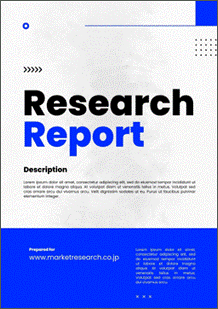 | • レポートコード:D0-MOR-AP1144 • 出版社/出版日:Mordor Intelligence / 2020年4月20日 • レポート形態:英文、PDF、90ページ • 納品方法:Eメール(受注後2-3営業日) • 産業分類:食品&飲料 |
| Single User | ¥629,000 (USD4,250) | ▷ お問い合わせ |
| Team User | ¥703,000 (USD4,750) | ▷ お問い合わせ |
| Corporate License | ¥1,110,000 (USD7,500) | ▷ お問い合わせ |
• お支払方法:銀行振込(納品後、ご請求書送付)
レポート概要
| 本調査レポートは、トニックウォーターの世界市場について調査・分析した資料で、トニックウォーターの市場概要、動向、セグメント別市場規模、地域別分析、競争状況、企業情報、市場機会分析などで構成されています。 |
The global tonic water market is projected to increase at a CAGR of 7.1%, during the forecast period, 2020-2025.
– Tonic water is a carbonated soft drink in which quinine is dissolved. Originally Tonic water was used as a medicine against malaria but now it has significantly lower quinine content and is consumed for its distinctive bitter flavor. It is often used in alcoholic drinks, particularly in gin and tonic.
– The market is driven by the rising disposable income of people due to modernization, promotion of tonic water as a mixer with alcohol, increasing popularity of tonic water because of availability of different variants and also due to the surging popularity in social media and internet which has led to the increased sale of tonic water.
Key Market Trends
Increasing Demand for Tonic Water
Diet tonic water is gaining increasing acceptance among the consumers owing to its lesser sugar content. As compared to regular, diet variants possess fewer calories or carbohydrates. Companies are also bringing in new naturally flavored water in this product segment, intending to cater to the consumers’ specific needs for diet consciousness and taste factors. For instance, Sodastream offers naturally flavored diet tonics with zero calories. Supermarket and hypermarket held the majority of the revenue share in the global tonic water market. However, with the introduction of new players, an increasing number of internet users, ease of access, fast-paced lifestyle, 24/7 availability, convenience and several options to choose from are some of the factors expected to drive the growth of these products through online medium. Companies are actively distributing their products through online channels either through their portals or third-party retailing to widen their consumer base.
North America Dominates the Market
North America accounted for a significant market share in the global tonic water market. North America is the second-largest supplier of tonic water in 2017. The popularity and surging demand for gin are expected to boost the acceptance of tonic mix in the next few years. The mixing of tonic water in alcoholic beverages is prominent in developed countries. The market is still at its nascent stage in the developing economies due to less awareness about the product and also a relatively lower preference of gin. As compared to North America and Europe, the Asian countries having a high consumption of gin such as the Philippines, do not use alcoholic mixers frequently.
Competitive Landscape
Some of major key players in the tonic water market, globally includes Fever-Tree, Keurig Dr Pepper, Inc., Hansen Beverage, Fentimans Ltd, SodaStream Inc. among others. In recent years, Fever-Tree has expanded its offering to include mixers for other spirits alongside tonic water. Its product line-up now includes Sicilian lemonade, Madagascan cola, ginger beer, and ginger ale. As with the company’s tonic water, many of those drinks come in various different flavors.
Reasons to Purchase this report:
– The market estimate (ME) sheet in Excel format
– Report customization as per the client’s requirements
– 3 months of analyst support
1 INTRODUCTION
1.1 Study Deliverables
1.2 Study Assumptions
1.3 Scope of the Study
2 RESEARCH METHODOLOGY
3 EXECUTIVE SUMMARY
4 MARKET DYNAMICS
4.1 Market Drivers
4.2 Market Restraints
4.3 Porter’s Five Force Analysis
4.3.1 Threat of New Entrants
4.3.2 Bargaining Power of Buyers/Consumers
4.3.3 Bargaining Power of Suppliers
4.3.4 Threat of Substitute Products
4.3.5 Intensity of Competitive Rivalry
5 MARKET SEGMENTATION
5.1 By Product Type
5.1.1 Regular Tonic Water
5.1.2 Low Calorie Tonic Water
5.1.3 Slimline Tonic Water
5.2 By Distribution Channel
5.2.1 Supermarkets/Hypermarket
5.2.2 Convenience stores
5.2.3 Online Retailer
5.2.4 Others
5.3 Geography
5.3.1 North America
5.3.1.1 United States
5.3.1.2 Canada
5.3.1.3 Mexico
5.3.1.4 Rest of North America
5.3.2 Europe
5.3.2.1 United Kingdom
5.3.2.2 Germany
5.3.2.3 France
5.3.2.4 Russia
5.3.2.5 Italy
5.3.2.6 Spain
5.3.2.7 Rest of Europe
5.3.3 Asia Pacific
5.3.3.1 India
5.3.3.2 China
5.3.3.3 Japan
5.3.3.4 Australia
5.3.3.5 Rest of Asia-Pacific
5.3.4 South America
5.3.4.1 Brazil
5.3.4.2 Argentina
5.3.4.3 Rest of South America
5.3.5 Middle East & Africa
5.3.5.1 South Africa
5.3.5.2 Saudi Arabia
5.3.5.3 Rest of Middle East & Africa
6 COMPETITIVE LANDSCAPE
6.1 Most Active Companies
6.2 Most Adopted Strategies
6.3 Market Share Analysis
6.4 Company Profiles
6.4.1 Fever-Tree
6.4.2 Keurig Dr Pepper, Inc.
6.4.3 Hansen Beverage
6.4.4 Fentimans Ltd
6.4.5 SodaStream Inc.
6.4.6 White Rock Beverage Ltd
6.4.7 El Guapo Bitters
6.4.8 The Coca-Cola Company
7 MARKET OPPORTUNITIES AND FUTURE TRENDS